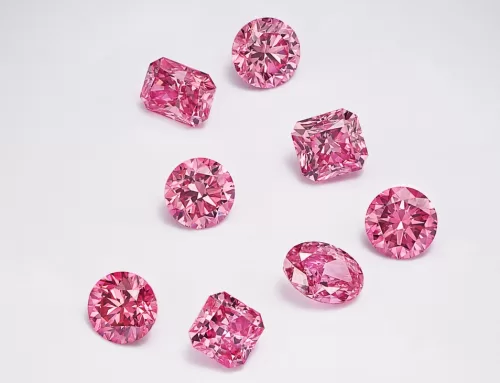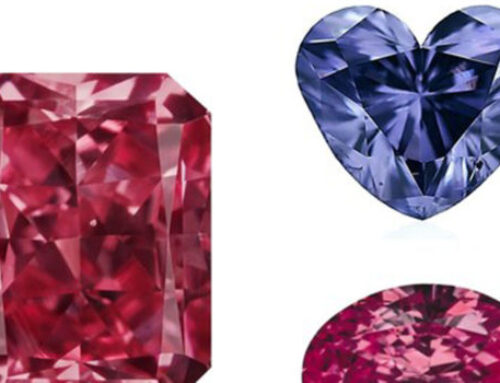Argyle Certification vs. No Argyle Certification (GIA only)
DEFINITIONS: Argyle Certified (cut and certified by the Argyle) Non-Argyle (not of Argyle origin) Argyle Origin (cut from Argyle seconds)
Abstract: This report takes a close look at why Argyle certified pink diamonds are growing in value at an astonishing rate and why non-Argyle pink diamonds have stagnated in value.
Point by point we unravel all aspects of why this is happening. We will also discuss the reasons why retail jewellers and diamond brokers are now resorting to using motivated misdirection and selling substandard pink diamonds as investments.
- Price Growth, Argyle vs. No Argyle Certification
- Argyle Certified vs. Argyle Origin
- Argyle vs. Non-Argyle DNA
- Traceable Rarity
- Argyle Colour vs. GIA Colour Grading
- Conclusion
- Price Growth, Argyle vs. No Argyle Certification
When it comes to the financial growth of a natural pink diamond, all statistics you read originate from a company called the “Fancy Color Research Foundation” (FCRF). This highly reputable organization tracks the international market behaviour and changes of the wholesale buying price of non-Argyle certified pink diamonds from 1.00ct plus in size. The index is an objective tool, based on exclusive data and refined real time information supplied by independent industry leaders. According to the FCRF, natural pink diamonds without Argyle certification have only increased in value by a mere 1% in the past five years and that 1% growth happened in 2019. This statistic is highly significant when compared to the 18.6% average increase in value of an Argyle certified diamond in the last 12 months. Thus, being no surprise that these pink diamonds are the preferred choice as a tangible investment.
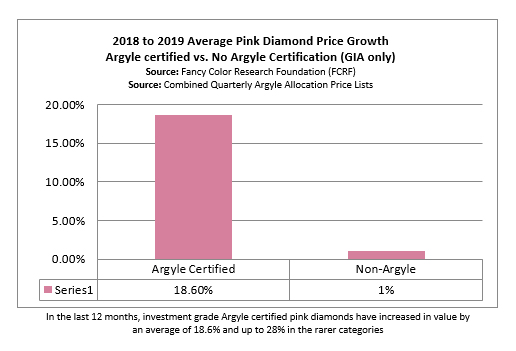
2. Argyle Certified vs. Argyle Origin
Let’s discuss the key points currently being addressed to sell an Argyle Origin diamond. They all come from the same source and have the same superior type Ia DNA. So why does the Argyle inscription and certification really matter?
It is common knowledge that 90% of the world’s production of pink diamonds originate from the Rio Tinto owned Argyle diamond mine. However, only a select number of these pink diamonds are cut and polished by the Argyle and the rest are sent off to auction.
Most of the Rio Tinto Diamonds’ (RTD), white and brown rough production is sold directly through regular contract sales to a selected group of core customers, known as Select Diamantaires. RTD also conducts alternative sales by invitation only, providing non-Select Diamantaires with the opportunity to access the Rio Tinto production. A full range of rough diamonds are offered to a global group of diamond companies through an auction-based sales channel called, Specials & Coloured Rough Tender. Two times per year, RTD offers fancy pink rough diamonds from the Argyle production via a sealed bid, first price auction system. Customers can buy large single stones and parcels comprising of a diverse range of sizes, shapes and qualities.
The pink diamond rough in these parcels are predominantly seconds, as they don’t make the high standards required by the Argyle brand. Because these diamonds are not cut and polished by the Argyle, they will not be laser inscribed with a unique serial number or be issued with an official Argyle certificate. Hence, cannot be accurately colour graded and statistically registered by Rio Tinto. Although some of these diamonds may look just as beautiful in colour as one polished by the Argyle diamond mine, they will always sell for a heavily reduced price and never have the same prestige, rarity and value.
3. Argyle vs. Non-Argyle DNA
Generally, all-natural pink diamonds fall into two DNA categories, Type Ia and Type IIa: Type IIa Pink Diamonds originate from Africa, Brazil, Russia, Canada and India. They were first identified when scientists found a link between diamonds sourced from the legendary Golconda Mine in India, which were distinguished by their absence of nitrogen. Type Ia Pink Diamonds are predominately Australian. They were first discovered in the mid 1980’s in the Kimberly region of Western Australia. They are known to be the most rare and valuable of all pink diamonds because of their unique attributes.
Published data by the Gemological Institute of America (GIA), has scientifically identified the following DNA characteristics between Type Ia Argyle and Type 11a Non-Argyle pink diamonds:
- Type IIa Pink Diamonds are formed in the volcanic rock kimberlite and tend to be larger in size but have weak saturation and intensity. They display the less popular warmer pink/orange overtones, have internal graining and are more likely to appear with an overall haze with varying degrees of transparency. Type IIa Pink Diamonds exhibit a phenomenon that causes a weakening of the colour saturation in daylight, giving them a lighter colour appearance.
- Type Ia Pink Diamonds are primarily formed in the volcanic rock lamproite and tend to be smaller in size, but stronger in saturation and intensity. They display the more popular cooler pink/magenta overtones. Type Ia Pink Diamonds do not exhibit any variance in degrees of transparency or loss of pink colour saturation in daylight.
4. Traceable Rarity
Only a certified Argyle pink or blue diamond has a unique serial number laser inscribed on its girdle. This number can be validated by the Argyle Diamond Mine and used to appraise its rarity through Argyle Diamond Analytics™ (ADA).
ADA is a data driven reporting system that evaluates every diamond that has been certified and inscribed by the Argyle mine since formal records have been kept. The system categorises the exact number of diamonds by colour, size, shape and clarity. With this information it is possible to statistically calculate the rarity of any Argyle pink or blue diamond. This traceable rarity is a very important factor to consider when investing, especially after the Argyle closes.
When you consider that non-Argyle pink diamonds will continue to be mined for decades to come, within several years, they will outnumber an Argyle pink diamonds. They can’t be tracked for rarity, as there are no formal records kept or any reporting systems available to do this! This factor alone makes an Argyle certified pink diamond the ultimate limited edition!
5. GIA Colour Grading vs. Argyle Colour Grading
The GIA grade all diamonds in the face-up position, in a white non-fluorescent plastic tray. The surrounding ambient lighting is removed from the equation by the use of a viewing box. Then, by using a standardised geometry system, the observer visually estimates the diamonds colour.
The diamond’s colour grade is based on a combination of its size, shape, faceting arrangement and color. GIA describes a single colour as being a “characteristic” of the diamond as a whole. This characteristic colour is the overall blend of appearance.
Once the characteristic colour has been determined, the diamond is side-by-side compared with two or more colour reference diamonds. The objective of the comparison process is to place the pink diamond between various colour strength reference diamonds, not to match it to a particular colour reference. This leaves a wide spectrum of colour saturations that will all be given the same GIA colour grade.
The Argyle pink colour grading system is the world’s most accurate way of determining a pink diamonds true colour and value. The Argyle uses a similar viewing box and grade in the same face-up position as the GIA. But unlike the GIA, the Argyle perfectly match their diamonds colour strength/saturations to an exact colour reference diamond. With 35-colour saturation in its system, compared to seven-colour saturation in the GIA grading system. This makes a GIA colour grade almost irrelevant to correctly value a pink diamond.
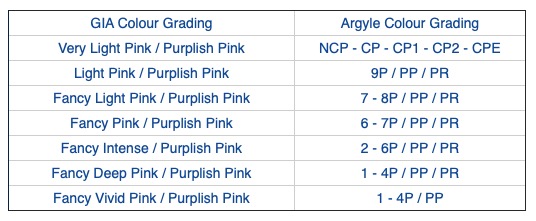
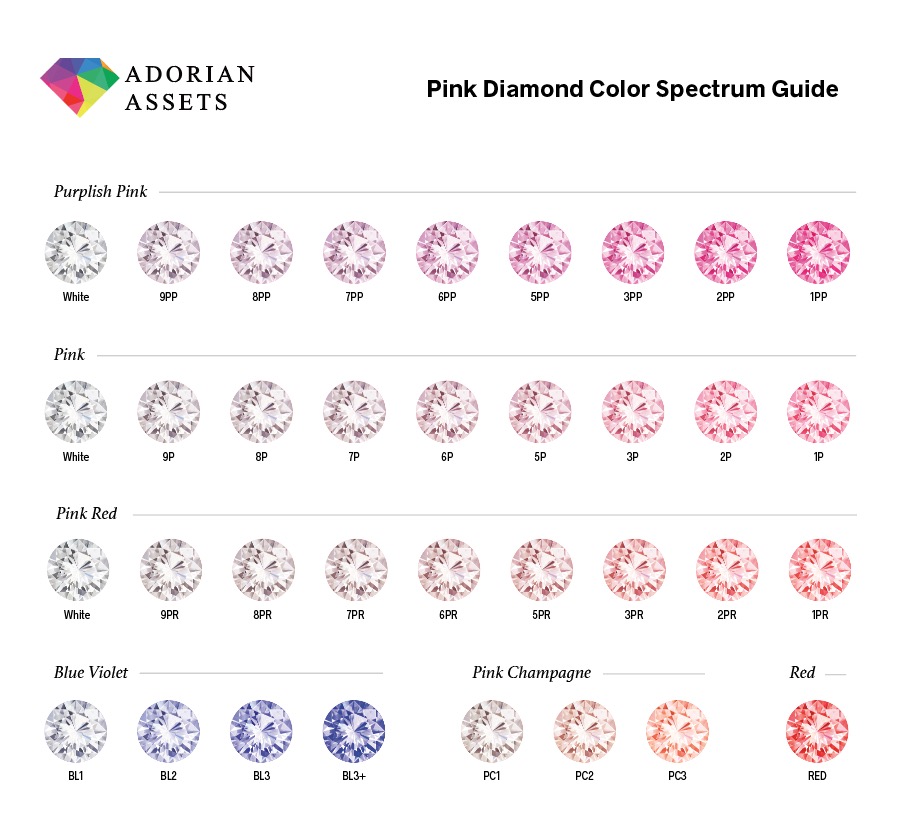
6. Conclusion
With the closure of the Rio Tinto Argyle mine, supply of these beyond rare diamonds will cease to exist outside of the secondary market from late 2020. There has been an enormous uplift in demand to obtain these natural treasures before supply ends. Basic economics says that when supply is restricted and demand increases, prices will rise, and this trend is expected to continue for many years to come. Making an Argyle certified pink diamond the ultimate limited edition. With the supply of Argyle Certified Diamonds drying up, Jewelers and diamond brokers are now resorting to selling inferior Non-Argyle and Argyle origin pink diamonds as a supposed investment, in order to financially capitalize on the closure of the Argyle mine.
This is potentially motivated-misdirection or at best, pure inexperience on their behalf. Regardless of how many creative stories you will hear about the possibility of these diamonds growing in value after the Argyle closes, the FACT is that these non-argyle and argyle origin pink diamonds are considered inferior as an investment option. This is due to their inherited DNA problems, their extremely low financial growth and their difficulties in being accurately colour graded and valued. They are also harder to resell and have no concept of appraising their rarity!
Summary: Argyle Certification vs. No Argyle Certification (GIA only)
Fact: Natural pink diamonds without Argyle certification have only increased in value by a mere 1% in the past five years! This statistic is highly significant when compared to the 18.6% average increase in value of an Argyle certified pink diamond in the last 12 months!
Fact: The Argyle pink colour grading system has 32-colour saturations, compared to seven-colour saturations in the GIA grading system. This makes the GIA colour grade almost irrelevant when attempting to accurately value a pink diamond.
Fact: Only a certified Argyle pink diamond has a unique serial number laser inscribed on its girdle. This number can be validated by the Argyle Diamond Mine and used to appraise its rarity. There has never been a standardised system in place to document the overall quality, number or rarity of a Non-Argyle pink diamond. Causing them to be impossible to value based on rarity.
Fact: Non-Argyle pink diamonds will continue to be mined for decades to come. It’s estimated that within several years of the Argyle closing, Non-Argyle pink diamonds will out number Argyle certified pink diamonds.
Fact: Published scientific data by the Gemological Institute of America (GIA), has identified that type Ia Argyle pink diamonds have superior DNA characteristics compared to all other natural pink diamonds. Argyle pink diamonds have stronger saturations of colour. They display the more popular cooler pink/magenta overtones and unlike Non-Argyle pink diamonds, they do not exhibit any variance in degrees of transparency or loss of pink colour saturation in daylight.
Fact: Argyle origin diamonds will not have the same returns as a certified Argyle diamond. Twice a year Rio Tinto offer parcels of fancy pink diamond rough from the Argyle production via a sealed bid auction system. The pink diamond rough contained in these parcels are predominantly Argyle seconds and rejection rough, as they don’t make the high standards required by the Argyle brand. Because these diamonds are not cut and polished by the Argyle, they will never have the same prestige, rarity and value. They cannot be accurately colour graded and will not have a traceable laser inscribed serial number on the diamond.


